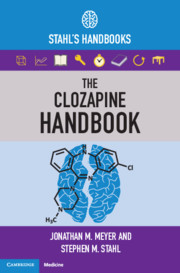Book contents
- The Clozapine Handbook
- The Clozapine Handbook
- Copyright page
- Additional material
- Contents
- Foreword
- Introduction
- 1 The Efficacy Story: Treatment-Resistant Schizophrenia, Psychogenic Polydipsia, Treatment-Intolerant Schizophrenia, Suicidality, Violence, Mania and Parkinson’s Disease Psychosis
- 2 Addressing Clozapine Positive Symptom Nonresponse in Schizophrenia Spectrum Patients
- 3 Initiating Clozapine
- 4 Discontinuing Clozapine and Management of Cholinergic Rebound
- 5 Binding Profile, Metabolism, Kinetics, Drug Interactions and Use of Plasma Levels
- 6 Understanding Hematologic Monitoring and Benign Ethnic Neutropenia
- 7 Managing Constipation
- 8 Managing Sedation, Orthostasis and Tachycardia
- 9 Managing Sialorrhea
- 10 Managing Seizure Risk and Stuttering
- 11 Managing Metabolic Adverse Effects
- 12 Fever, Myocarditis, Interstitial Nephritis, DRESS, Serositis and Cardiomyopathy
- 13 Managing Enuresis and Incontinence, Priapism, Venous Thromboembolism, Neuroleptic Malignant Syndrome, Tardive Dyskinesia and Obsessive Compulsive Disorder
- 14 Eosinophilia, Leukocytosis, Thrombocytopenia, Thrombocytosis, Anemia, Hepatic Function Abnormalities
- 15 Special Topics: Child and Adolescent Patients, Elderly Patients, Patients With Intellectual Disability, Pregnancy and Risk for Major Congenital Malformation, Lactation, Overdose, Postmortem Redistribution
- Index
- References
1 - The Efficacy Story: Treatment-Resistant Schizophrenia, Psychogenic Polydipsia, Treatment-Intolerant Schizophrenia, Suicidality, Violence, Mania and Parkinson’s Disease Psychosis
Published online by Cambridge University Press: 19 October 2021
- The Clozapine Handbook
- The Clozapine Handbook
- Copyright page
- Additional material
- Contents
- Foreword
- Introduction
- 1 The Efficacy Story: Treatment-Resistant Schizophrenia, Psychogenic Polydipsia, Treatment-Intolerant Schizophrenia, Suicidality, Violence, Mania and Parkinson’s Disease Psychosis
- 2 Addressing Clozapine Positive Symptom Nonresponse in Schizophrenia Spectrum Patients
- 3 Initiating Clozapine
- 4 Discontinuing Clozapine and Management of Cholinergic Rebound
- 5 Binding Profile, Metabolism, Kinetics, Drug Interactions and Use of Plasma Levels
- 6 Understanding Hematologic Monitoring and Benign Ethnic Neutropenia
- 7 Managing Constipation
- 8 Managing Sedation, Orthostasis and Tachycardia
- 9 Managing Sialorrhea
- 10 Managing Seizure Risk and Stuttering
- 11 Managing Metabolic Adverse Effects
- 12 Fever, Myocarditis, Interstitial Nephritis, DRESS, Serositis and Cardiomyopathy
- 13 Managing Enuresis and Incontinence, Priapism, Venous Thromboembolism, Neuroleptic Malignant Syndrome, Tardive Dyskinesia and Obsessive Compulsive Disorder
- 14 Eosinophilia, Leukocytosis, Thrombocytopenia, Thrombocytosis, Anemia, Hepatic Function Abnormalities
- 15 Special Topics: Child and Adolescent Patients, Elderly Patients, Patients With Intellectual Disability, Pregnancy and Risk for Major Congenital Malformation, Lactation, Overdose, Postmortem Redistribution
- Index
- References
Summary
The 60th anniversary of clozapine’s synthesis by Schmutz and Eichenberger at Wander Pharmaceuticals was celebrated in 2018, although the chemists involved hoped that their tricyclic compound HF-1854 would possess antidepressant effects. In January 1961, the first pharmacological report on HF-1854 described an agent with sedative and antiadrenergic properties that resembled chlorpromazine, but which did not induce catalepsy. Further animal testing reported in December 1961 established a range of activities comparable to chlorpromazine but without the catalepsy induction seen with haloperidol. In 1962 the first open clinical trial of HF-1854 found limited efficacy at the dose of 160 mg TID (n = 19), but later that year Gross and Langer in Vienna found good results in 21 of 28 patients at similar dosing, again without neurological adverse effects. Further trial reports to Wander Pharmaceuticals in 1966 by Hippius in Berlin and Engelmeier in Vienna indicated that this was an effective but sedating antipsychotic that appeared free of neurological side effects. Wander completed further toxicological assays in 1967 and embarked on multiple clinical trials resulting in product registration in 1971, and marketing the following year under the trade name Leponex. A spate of severe neutropenia cases from Finland in 1975 led to clozapine’s withdrawal from the market in most countries, although it was available under humanitarian programs with hematological monitoring.
- Type
- Chapter
- Information
- The Clozapine HandbookStahl's Handbooks, pp. 10 - 43Publisher: Cambridge University PressPrint publication year: 2019

